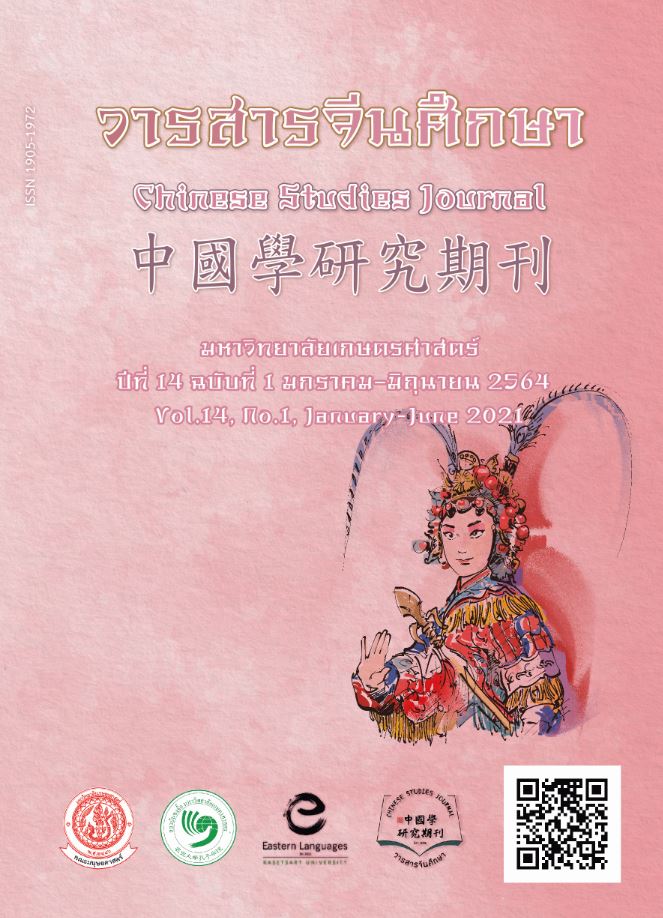Reconsidering Types of Teochew Dialect Loanwords in Thai and Their Semantic Changes
Main Article Content
Abstract
Teochew people have begun to leave their home and immigrated to Thailand in order to survive. Any type of contact will bring about the contact between the two language communities. In the process of language contact, borrowing is often accompanied. As a result, the lexical items in Teochew Dialect are transmitted or transferred to Thai in a certain borrowing way and formed the vocabulary system of Teochew Dialect Loanwords in Thai. The vocabulary system has a large number, which can be classified according to the way of borrowing and the degree of assimilation. When Teochew vocabulary items are borrowed by Thai, the meaning of words may change due to some factors such as narrowing, expansion, and transfer.
Article Details
ผลงานทางวิชาการที่ลงตีพิมพ์ในวารสารจีนศึกษา มหาวิทยาลัยเกษตรศาสตร์ เป็นลิขสิทธิ์ของผู้เขียนหรือผู้แปลผลงานนั้น หากนำลงในวารสารจีนศึกษาเป็นครั้งแรก เจ้าของผลงานสามารถนำไปตีพิมพ์ซ้ำในวารสารหรือหนังสืออื่นได้โดยมิต้องแจ้งให้ทราบล่วงหน้า แต่หากผลงานที่ได้รับพิจารณานำลงในวารสารจีนศึกษา เป็นผลงานที่เคยตีพิมพ์ที่อื่นมาก่อนเจ้าของผลงานต้องจัดการเรื่องปัญหาลิขสิทธิ์กับแหล่งพิมพ์แรกเอง หากเกิดปัญหาทางกฎหมาย ถือว่าไม่อยู่ในความรับผิดชอบของวารสารจีนศึกษา มหาวิทยาลัยเกษตรศาสตร์ ทั้งนี้ ความคิดเห็นต่างๆ ในบทความเป็นความคิดเห็นส่วนตัวของผู้เขียน ไม่เกี่ยวกับกองบรรณาธิการวารสารจีนศึกษา มหาวิทยาลัยเกษตรศาสตร์
References
Thomason, S. (2001). Language Contact. Edinburgh: Edinburgh University Press. Ghil’ad, Zuckermann (2000). Camouflaged Borrowing: “Folk – Etymological Nativization” in the Service of Puristic Language Engineering, University of Oxford.
李益杰(2004). 海外潮汕华侨华人集中于泰国的原因浅析. 东南亚, 01: 49-53.
李泰盛(2004).泰语中潮州话借词及其词义嬗变说略.汕头大学 学报,03:72-76
顾江萍(2009). 汉语对日语借词的显性改造与隐性吸收. 长江学术, 04: 112-117.
刘雅贤(2010).泰语商业用语中的潮州话借词.语文学刊,10:11-12.
曾仁山(2011).泰语潮州话借词语义异变情况及其原因.宜春学院 学报,33(01):140-142.
เจริญ เพ็ชรรัตน. (2012). ข้อสังเกตของคำยืมภาษาแต้จิ๋วในสังคมไทย. วารสารมนุษยศาสตร์สาร.01:62-74.
อภิชาญ ปานเจริญ. (2561). ภาษาต่างประเทศในภาษาไทย.กรุงเทพมหานคร:สำนักพิมพ์มหาวิทยาลัยรามคำแหง.


